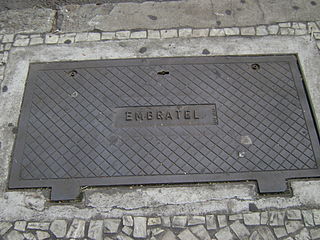
SBS 4 was a geostationary communications satellite designed and manufactured by Hughes on the HS-376 platform. It was ordered by Satellite Business Systems, which later sold it to Hughes Communications. It had a Ku band payload and operated at 94°W longitude.
Satmex was a company set up in Mexico in the mid-1990s through 2014 that operated space communication satellites that provide services to the Americas.
Star One C2 is a Brazilian communications satellite. It was launched on 18 April 2008 22:17 UTC by an Ariane 5ECA carrier rocket, as part of a dual-payload launch with Vinasat-1. It was built by Thales Alenia Space, based on the Spacebus-3000B3 satellite bus. It will be operated by Star One, a subsidiary of Embratel, and Bolivarsat.
Brasilsat A1 was a Brazilian communications satellite which was operated by Embratel. It was constructed by the Spar Aerospace, and is based on the HS-376 satellite bus. The Brasilsat A1 was off duty in March 2002 and was transferred to the graveyard orbit.
Star One B4, originally deignated Brasilsat B4 is a Brazilian communications satellite which is operated by Star One. It was constructed by the Hughes Space and Communications Company, and is based on the HS-376W satellite bus. It was the penultimate HS-376, and final HS-376W to be launched. Its launch was contracted by Arianespace, using an Ariane 4 44LP-3 carrier rocket. The launch occurred at 23:16 GMT on 17 August 2000, from the ELA-2 launch pad at the Guiana Space Centre. The Nilesat 102 satellite was launched on the same rocket.
Galaxy 11 is an American geostationary communications satellite which is operated by Intelsat. It is located in geostationary orbit at a longitude of 32.8 degrees east, where it serves as a backup to the Intelsat 802 spacecraft. It was originally operated at 99° West and later spent most of its operational life at 91° West, from where it was used to provide communications services to Brazil and North America.
Intelsat 602, also known as IS-602 and previously named Intelsat VI F-2, is a communications satellite operated by Intelsat. Launched in 1989, it was the first of five Intelsat VI satellites to be launched. The Intelsat VI series was constructed by Hughes Aircraft, based on the HS-389 satellite bus. As of 2012, Intelsat 602 remains operational.
Intelsat 605, previously named Intelsat VI F-5, was a communications satellite operated by Intelsat. Launched in 1991, it was the fourth of five Intelsat VI satellites to be launched. The Intelsat VI series was constructed by Hughes Aircraft, based on the HS-389 satellite bus.
Turksat 1B was a Turkish communications satellite as part of a project to form an instant network with two geosynchronous satellites that is supervised by the companies Türksat A.Ş. in Turkey and Aérospatiale of France.
BSAT-1a was a geostationary communications satellite designed and manufactured by Hughes on the HS-376 platform. It was originally ordered and operated by the Broadcasting Satellite System Corporation (B-SAT). It was used as the main satellite to broadcast television channels for NHK and WOWOW over Japan. It had a pure Ku band payload and operated on the 110°E longitude until it was replaced, along its backup BSAT-1b, by BSAT-3a. On 3 August 2010, it was decommissioned and placed on a graveyard orbit.
Galaxy 9 (G-9) was a geostationary communication satellite built by Hughes. It was located at an orbital position of 81 degrees west longitude and was initially operated by PanAmSat and later by Intelsat. The satellite was based on the HS-376 platform and its life expectancy was 15 years. The satellite was successfully launched into space on May 23, 1996, at 01:09:59 UTC, by means of a Delta II vehicle from Cape Canaveral Air Force Station, United States. It had a launch mass of 3080 pounds.
Brasilsat B3 is a Brazilian communications satellite. It was launched on 4 February 1998 by an Ariane 44LP carrier rocket, as part of a dual-payload launch with Inmarsat-3 F5. It was built by Hughes Aircraft, based on the HS-376 satellite bus. It operates by Star One, a subsidiary of Embratel.
Intelsat 701 is a geostationary communication satellite that was built by Space Systems/Loral (SSL). It is located in the orbital position of 29.5 degrees east longitude and it is currently in an inclined orbit. The same is owned by Intelsat. The satellite was based on the LS-1300 platform and its estimated useful life was 15 years.
Intelsat 701 is a geostationary communication satellite that was built by Space Systems/Loral (SSL). It is located in the orbital position of 32.9 degrees east longitude and it is currently in an inclined orbit. The same is owned by Intelsat. The satellite was based on the HS-601 platform and its estimated useful life was 15 years.
Intelsat 707 is a geostationary communication satellite that was built by Space Systems/Loral (SSL). It is located in the orbital position of 53 degrees west longitude and it is currently in an inclined orbit. The same is owned by Intelsat. The satellite was based on the LS-1300 platform and its estimated useful life was 15 years.

The Geostationary Defense and Strategic Communications Satellite or SGDC is a Brazilian geostationary communication satellite that was built by Thales Alenia Space in France, it was placed in the orbital position of 75 degrees west longitude and will be operated by Telebrás. Telebrás selected Viasat as a partner to help build the associated ground system. The satellite was based on the Spacebus-4000 platform and its life expectancy will be 18 years.
Intelsat 802 was a communications satellite operated by Intelsat. Launched in 1997 it was operated in geostationary orbit at a longitude of 174 degrees west for around fourteen years.










